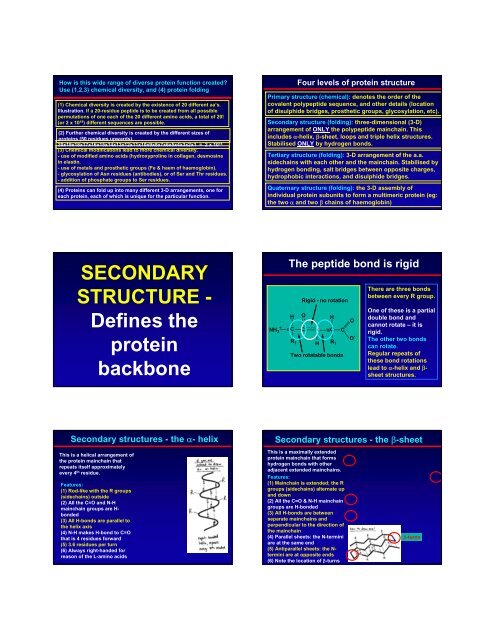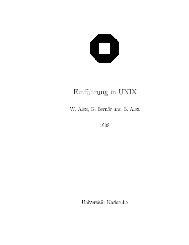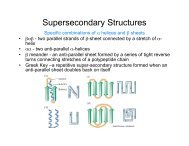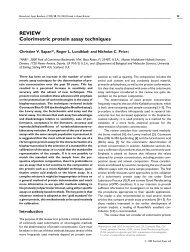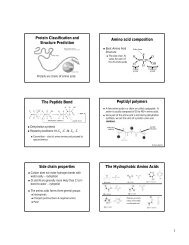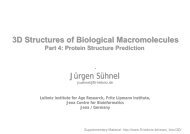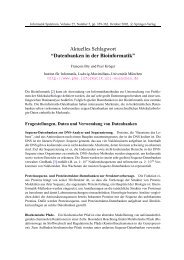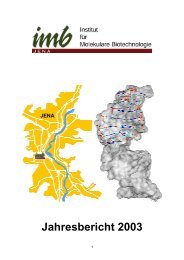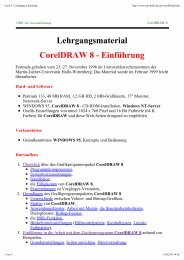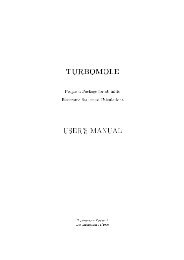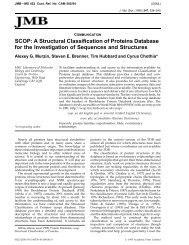MAINCHAIN PART OF AMINO ACIDS
MAINCHAIN PART OF AMINO ACIDS
MAINCHAIN PART OF AMINO ACIDS
You also want an ePaper? Increase the reach of your titles
YUMPU automatically turns print PDFs into web optimized ePapers that Google loves.
How is this wide range of diverse protein function created?<br />
Use (1,2,3) chemical diversity, and (4) protein folding<br />
(1) Chemical diversity is created by the existence of 20 different aa’s.<br />
Illustration. If a 20-residue peptide is to be created from all possible<br />
permutations of one each of the 20 different amino acids, a total of 20!<br />
(or 2 x 10 18 ) different sequences are possible.<br />
(2) Further chemical diversity is created by the different sizes of<br />
proteins (50 residues upwards).<br />
20x19x18x17x16x15x14x13x12x11x10x9x8x7x6x5x4x3x2x1 = 2 x 10 18<br />
(3) Chemical modifications lead to more chemical diversity.<br />
- use of modified amino acids (hydroxyproline in collagen, desmosine<br />
in elastin.<br />
- use of metals and prosthetic groups (Fe & haem of haemoglobin).<br />
- glycosylation of Asn residues (antibodies), or of Ser and Thr residues.<br />
- addition of phosphate groups to Ser residues.<br />
(4) Proteins can fold up into many different 3-D arrangements, one for<br />
each protein, each of which is unique for the particular function.<br />
Four levels of protein structure<br />
Primary structure (chemical): denotes the order of the<br />
covalent polypeptide sequence, and other details (location<br />
of disulphide bridges, prosthetic groups, glycosylation, etc).<br />
Secondary structure (folding): three-dimensional (3-D)<br />
arrangement of ONLY the polypeptide mainchain. This<br />
includes α-helix, β-sheet, loops and triple helix structures.<br />
Stabilised ONLY by hydrogen bonds.<br />
Tertiary structure (folding): 3-D arrangement of the a.a.<br />
sidechains with each other and the mainchain. Stabilised by<br />
hydrogen bonding, salt bridges between opposite charges,<br />
hydrophobic interactions, and disulphide bridges.<br />
Quaternary structure (folding): the 3-D assembly of<br />
individual protein subunits to form a multimeric protein (eg:<br />
the two α and two β chains of haemoglobin)<br />
SECONDARY<br />
STRUCTURE -<br />
Defines the<br />
protein<br />
backbone<br />
NH 3<br />
+<br />
The peptide bond is rigid<br />
H<br />
αC<br />
R 1<br />
Rigid - no rotation<br />
O<br />
C<br />
N<br />
H<br />
H<br />
αC<br />
C<br />
O<br />
R 1<br />
O -<br />
Two rotatable bonds<br />
There are three bonds<br />
between every R group.<br />
One of these is a partial<br />
double bond and<br />
cannot rotate – it is<br />
rigid.<br />
The other two bonds<br />
can rotate.<br />
Regular repeats of<br />
these bond rotations<br />
lead to α-helix and β-<br />
sheet structures.<br />
Secondary structures - the α- helix<br />
This is a helical arrangement of<br />
the protein mainchain that<br />
repeats itself approximately<br />
every 4 th residue.<br />
Features:<br />
(1) Rod-like with the R groups<br />
(sidechains) outside<br />
(2) All the C=O and N-H<br />
mainchain groups are H-<br />
bonded<br />
(3) All H-bonds are parallel to<br />
the helix axis<br />
(4) N-H makes H-bond to C=O<br />
that is 4 residues forward<br />
(5) 3.6 residues per turn<br />
(6) Always right-handed for<br />
reason of the L-amino acids<br />
Secondary structures - the β-sheet<br />
This is a maximally extended<br />
protein mainchain that forms<br />
hydrogen bonds with other<br />
adjacent extended mainchains.<br />
Features:<br />
(1) Mainchain is extended; the R<br />
groups (sidechains) alternate up<br />
and down<br />
(2) All the C=O & N-H mainchain<br />
groups are H-bonded<br />
(3) All H-bonds are between<br />
separate mainchains and<br />
perpendicular to the direction of<br />
the mainchain<br />
(4) Parallel sheets: the N-termini<br />
are at the same end<br />
(5) Antiparallel sheets: the N-<br />
termini are at opposite ends<br />
(6) Note the location of β-turns<br />
β-turns


